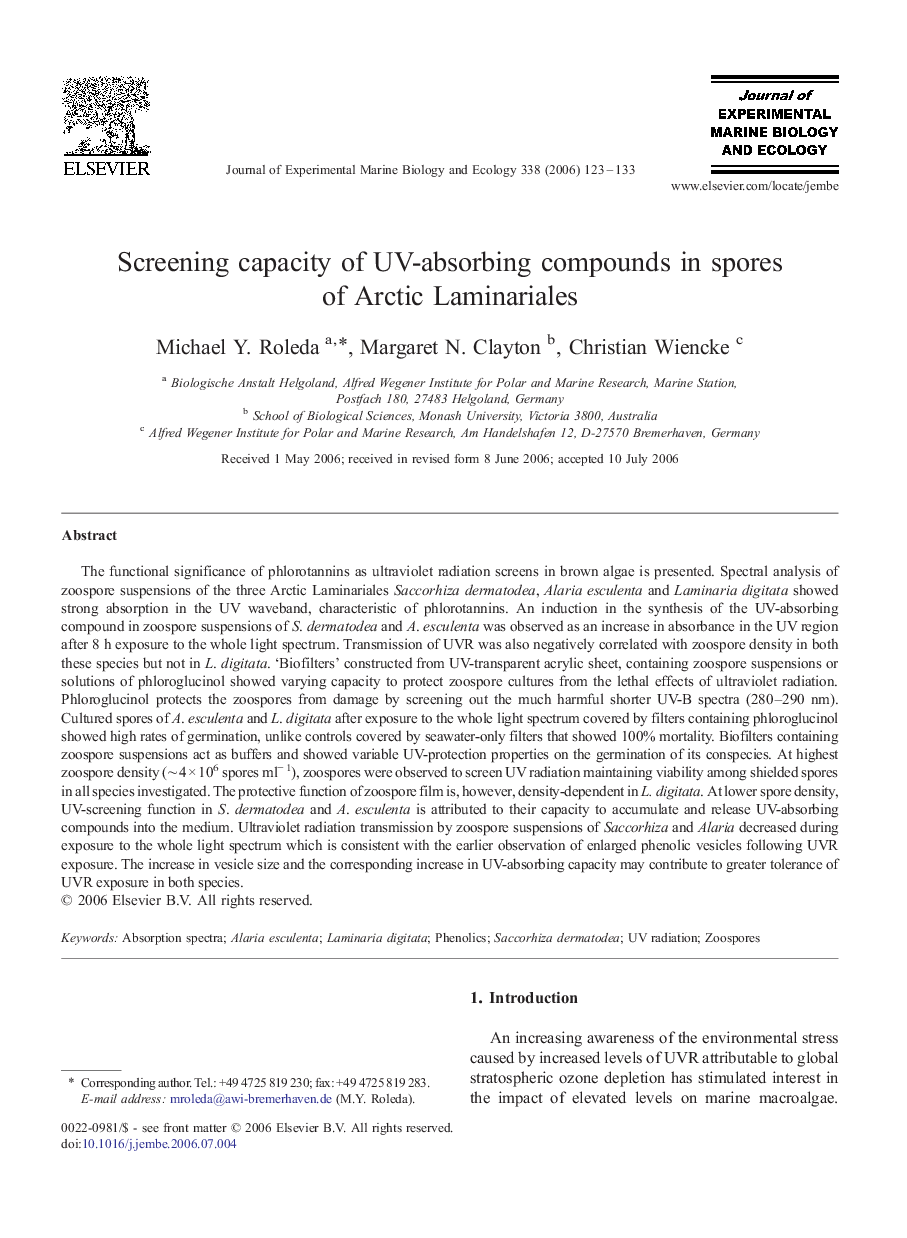| کد مقاله | کد نشریه | سال انتشار | مقاله انگلیسی | نسخه تمام متن |
|---|---|---|---|---|
| 4397894 | 1305912 | 2006 | 11 صفحه PDF | دانلود رایگان |
عنوان انگلیسی مقاله ISI
Screening capacity of UV-absorbing compounds in spores of Arctic Laminariales
دانلود مقاله + سفارش ترجمه
دانلود مقاله ISI انگلیسی
رایگان برای ایرانیان
کلمات کلیدی
موضوعات مرتبط
علوم زیستی و بیوفناوری
علوم کشاورزی و بیولوژیک
علوم آبزیان
پیش نمایش صفحه اول مقاله

چکیده انگلیسی
The functional significance of phlorotannins as ultraviolet radiation screens in brown algae is presented. Spectral analysis of zoospore suspensions of the three Arctic Laminariales Saccorhiza dermatodea, Alaria esculenta and Laminaria digitata showed strong absorption in the UV waveband, characteristic of phlorotannins. An induction in the synthesis of the UV-absorbing compound in zoospore suspensions of S. dermatodea and A. esculenta was observed as an increase in absorbance in the UV region after 8 h exposure to the whole light spectrum. Transmission of UVR was also negatively correlated with zoospore density in both these species but not in L. digitata. 'Biofilters' constructed from UV-transparent acrylic sheet, containing zoospore suspensions or solutions of phloroglucinol showed varying capacity to protect zoospore cultures from the lethal effects of ultraviolet radiation. Phloroglucinol protects the zoospores from damage by screening out the much harmful shorter UV-B spectra (280-290 nm). Cultured spores of A. esculenta and L. digitata after exposure to the whole light spectrum covered by filters containing phloroglucinol showed high rates of germination, unlike controls covered by seawater-only filters that showed 100% mortality. Biofilters containing zoospore suspensions act as buffers and showed variable UV-protection properties on the germination of its conspecies. At highest zoospore density (â¼Â 4 Ã 106 spores mlâ 1), zoospores were observed to screen UV radiation maintaining viability among shielded spores in all species investigated. The protective function of zoospore film is, however, density-dependent in L. digitata. At lower spore density, UV-screening function in S. dermatodea and A. esculenta is attributed to their capacity to accumulate and release UV-absorbing compounds into the medium. Ultraviolet radiation transmission by zoospore suspensions of Saccorhiza and Alaria decreased during exposure to the whole light spectrum which is consistent with the earlier observation of enlarged phenolic vesicles following UVR exposure. The increase in vesicle size and the corresponding increase in UV-absorbing capacity may contribute to greater tolerance of UVR exposure in both species.
ناشر
Database: Elsevier - ScienceDirect (ساینس دایرکت)
Journal: Journal of Experimental Marine Biology and Ecology - Volume 338, Issue 1, 24 October 2006, Pages 123-133
Journal: Journal of Experimental Marine Biology and Ecology - Volume 338, Issue 1, 24 October 2006, Pages 123-133
نویسندگان
Michael Y. Roleda, Margaret N. Clayton, Christian Wiencke,